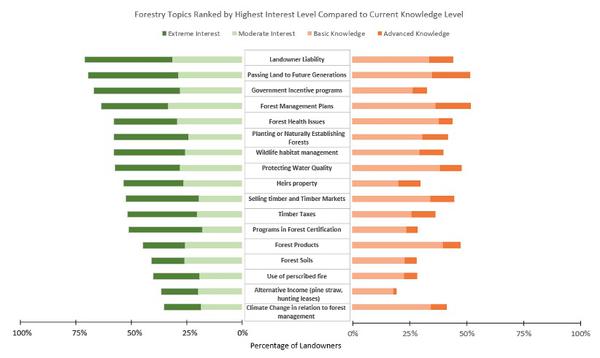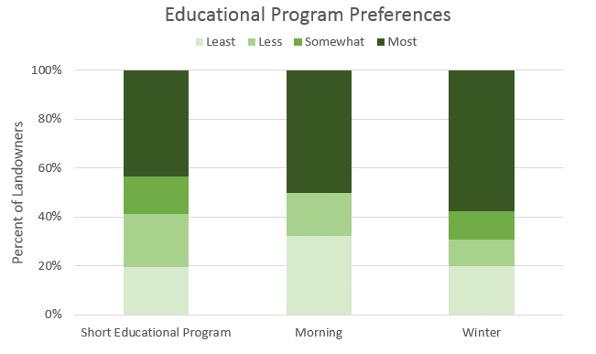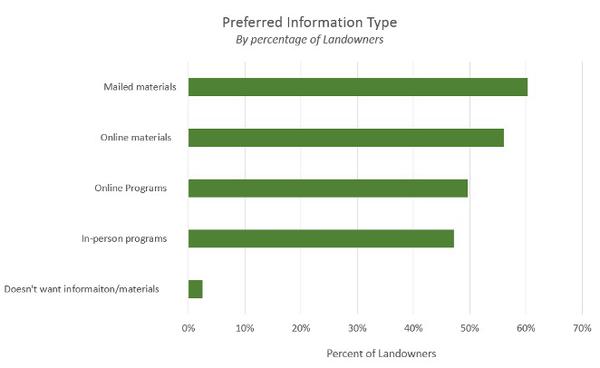Introduction
NC State Extension is responsible for providing educational opportunities to over 525,000 non industrial private forest (NIPF) landowners who own 65% of North Carolina’s valuable forest resource. For these landowners to be able to make informed decisions concerning the management of their forest land NC State Extension must be able to provide educational opportunities based on the landowner’s educational needs. To determine these educational needs, NC State Extension Forestry conducted a state-wide survey of a sample of 3000 NC NIPF landowners across 15 of the 100 North Carolina counties. The purpose of the needs assessment was to collect the necessary data needed to determine program priorities and preferred delivery methods of the landowners. The information collected through this survey, which is summarized below, will be used in the development of educational programs and approaches that meet the educational needs of NIPF landowners in North Carolina.
The NC NIPF Landowner
NC NIPF landowners are predominately well-educated, older white males (average age is 66 years; range from 25-104 years) who are either retired (50%) or employed full time (40%). They own approximately 290 acres (range 20-15,000 acres) of forestland and have owned forestland for about 25 years, though almost a quarter (23%) have owned forestland for less than 10 years. The majority (71%) of NC NIPF landowners live within 60 minutes or less of their forest holdings.
Reasons for Owning Their Land
NC NIPF landowners were asked to express their level of importance (Not important to Extremely important) for 13 potential reasons for owning forestland (Figure 1). Most landowners indicated that non-economic reasons were more important (Moderate to Extremely important) in owning their land than economic reasons. The top 3 reasons NIPF landowners own their land focus on conservation, wildlife, and aesthetics.

Figure 1. Percentage of NIPF Landowner’s for each reason for owning land by level of importance
K. Peters CC BY 4.0
Current Level of Interest and Knowledge
Landowners expressed their current level of interest and knowledge for 17 forestry topics (Figure 2). Of the 17 topics 12 of the topics had 50% or more of the landowners having moderate to extreme interest in the topic, but less than 50% had a basic to advance knowledge level of 15 of the topics. The top 5 topics of interest relate to owning and managing land with less focus on economic-based topics such as selling timber and timber markets, which ranked 10th, and timber taxes, which ranked 11th. Of the top 5 topics of interest, a majority of landowners express having the most knowledge on passing their land to future generations and forest management plans. For the remaining topics the majority of landowners had a minimum knowledge level of the subject area indicating the need for more educational programs and materials.

Figure 2. Comparison of forestry topics ranked by highest level of interest (Moderate or Extreme) and the corresponding level of current knowledge (Basic or Advanced)
K. Peters CC BY 4.0
Programming Preferences
The majority (58%) of NC NIPF landowners prefer to have programs that take place in the winter months with 49% of them ranking short educational program as most preferred, and 50% preferring that the program takes place during the morning (Figure 3).

Figure 3. The most preferred program type, time of day, and time of year by percentage of landowners for each preference level
K. Peters CC BY 4.0
Material and Program Types
NIPF Landowner’s more often selected mailed materials over the other options; however, online materials and programs did not follow far behind (Figure 4). “Doesn’t want information or materials” was only selected by 3% of landowners indicating a small number of landowners do not want any information at all (Figure 4).

Figure 4. The percentage of landowners who prefer each information and material type
K. Peters CC BY 4.0
Educational Limitations
Only 11% of NC NIPF landowners feel they are meeting their educational needs when it comes to forestry (Table 1). The majority (58%) of landowners’ lack awareness of educational programs being offered, suggesting the need for increased marketing of programs.
| Top 3 Educational Limitations | Percent of Landowners |
|---|---|
| Not aware of programs | 58% |
| Not enough time | 15% |
| I am currently meeting my educational needs | 11% |
Awareness of Information Sources
Fifty percent of landowners are aware of N.C. Cooperative Extension as an information source; however, only 23% of landowners use Extension as a secondary or primary source. The NC Forest Service has the most use at 38% (secondary and primary) while the majority of landowners are most unaware of Forest landowner associations (Table 2).
| Percent of Landowner's Awareness Level | ||||
|---|---|---|---|---|
| Information Source | Not Aware | Aware, but do not use | Secondary Sources | Primary Sources |
| North Carolina Forest Service | 15% | 46% | 16% | 22% |
| Consulting Forester | 31% | 32% | 11% | 26% |
| North Carolina Cooperative Extension | 27% | 50% | 16% | 7% |
| Media | 44% | 42% | 12% | 3% |
| Logger or Timber Buyer | 33% | 45% | 15% | 6% |
| Non Government Organizations | 39% | 47% | 10% | 4% |
| Federal Agencies | 41% | 44% | 11% | 4% |
| Neighbors | 34% | 40% | 22% | 4% |
| Forest Landowner Associations | 59% | 34% | 55 | 2% |
Publication date: Oct. 20, 2020
N.C. Cooperative Extension prohibits discrimination and harassment regardless of age, color, disability, family and marital status, gender identity, national origin, political beliefs, race, religion, sex (including pregnancy), sexual orientation and veteran status.
N.C. Cooperative Extension prohibits discrimination and harassment regardless of age, color, disability, family and marital status, gender identity, national origin, political beliefs, race, religion, sex (including pregnancy), sexual orientation and veteran status.
